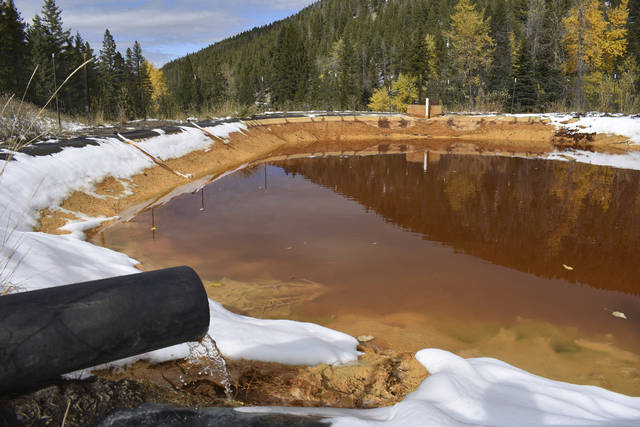https://triblive.com/news/world/u-s-mining-sites-dump-50-million-gallons-of-fouled-wastewater-daily/
U.S. mining sites dump 50 million gallons of fouled wastewater daily

RIMINI, Mont. — Every day many millions of gallons of water loaded with arsenic, lead and other toxic metals flow from some of the most contaminated mining sites in the United States and into surrounding lakes and streams without being treated, the Associated Press has found.
That torrent is poisoning aquatic life and tainting drinking water sources in Montana, California, Colorado, Oklahoma and at least five other states.
The pollution is a legacy of how the mining industry was allowed to operate in the United States for more than a century. Companies that built mines for silver, lead, gold and other “hardrock” minerals could move on once they were no longer profitable, leaving behind tainted water that still leaks out of the mines or is cleaned up at taxpayer expense.
Using data from public records requests and independent researchers, the AP examined 43 mining sites under federal oversight, some containing dozens or even hundreds of individual mines.
The records show that at average flows, more than 50 million gallons of contaminated wastewater streams daily from the sites. In many cases, it runs untreated into nearby groundwater, rivers and ponds — a roughly 20-million-gallon daily dose of pollution that could fill more than 2,000 tanker trucks.
The remainder of the waste is captured or treated in a costly effort that will need to carry on indefinitely, for perhaps thousands of years, often with little hope for reimbursement.
The volumes vastly exceed the release from Colorado’s Gold King Mine disaster in 2015, when an EPA cleanup crew inadvertently triggered the release of 3 million gallons of mustard-colored mine sludge, fouling rivers in three states.
At many mines, the pollution has continued decades after their enlistment in the federal Superfund cleanup program for the nation’s most hazardous sites, which faces sharp cuts under President Donald Trump.
Federal officials fear that at least six of the sites examined by AP could have blowouts like the one at Gold King.
Some sites feature massive piles or impoundments of mine waste known as tailings. A tailings dam collapse in Brazil last month killed at least 169 people and left 140 missing. A similar 2014 accident in British Columbia swept millions of cubic yards of contaminated mud into a nearby lake, resulting in one of Canada’s worst environmental disasters.
But even short of a calamitous accident, many mines pose the chronic problem of relentless pollution.
__________
Tainted wells
In mountains outside the Montana capital of Helena, about 30 households can’t drink their tap water because groundwater was polluted by about 150 abandoned gold, lead and copper mines that operated from the 1870s until 1953.
The community of Rimini was added to the Superfund list in 1999. Contaminated soil in residents’ yards was replaced, and the EPA has provided bottled water for a decade. But polluted water still pours from the mines and into Upper Tenmile Creek.
“The fact that bottled water is provided is great,” said 30-year Rimini resident Catherine Maynard, a natural resources analyst for the U.S. Department of Agriculture. “Where it falls short is it’s not piped into our home. Water that’s piped into our home is still contaminated water. Washing dishes and bathing — that metal-laden water is still running through our pipes.”
Estimates of the number of such abandoned mine sites range from 161,000 in 12 western states to as many as 500,000 nationwide. At least 33,000 have degraded the environment, according to the Government Accountability Office, and thousands more are discovered every year.
Officials have yet to complete work including basic risk analyses on about 80 percent of abandoned mining sites on federal lands. Most are controlled by the Bureau of Land Management, which under Trump is seeking to consolidate mine cleanups with another program and cut their combined 2019 spending from $35 million to $13 million.
Copyright ©2025— Trib Total Media, LLC (TribLIVE.com)
